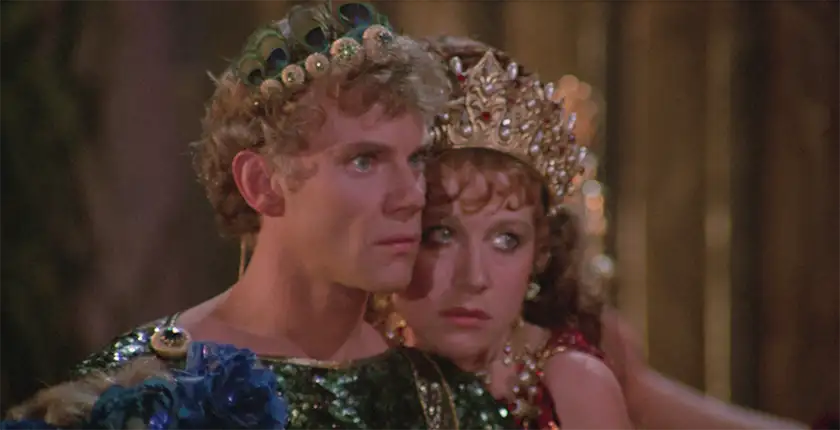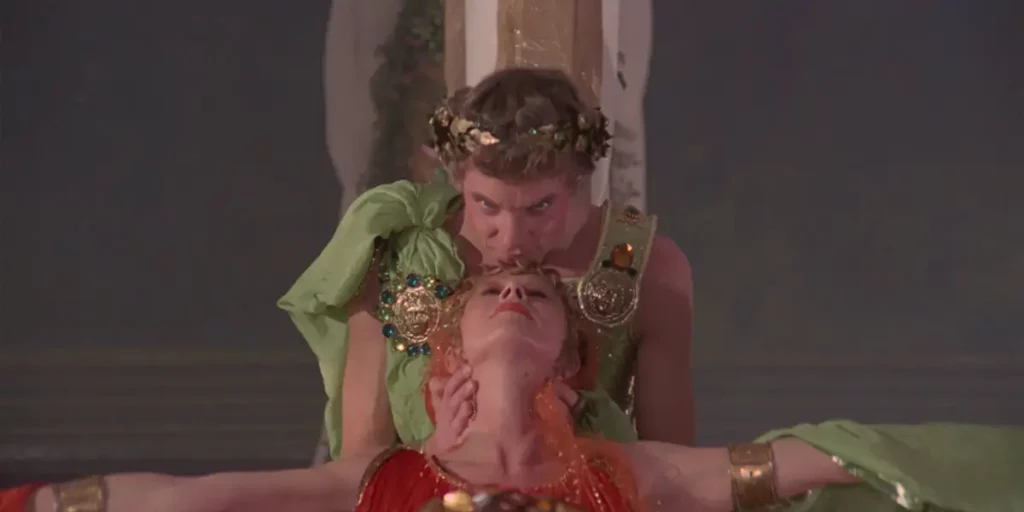Caligula: The Ultimate Cut is an imposing, masterful restoration that breathes new life into what is known as the most notorious film of the 1970s.
Director: Tinto Brass
Genre: Drama, History
Run Time: 178′
US Release: August 16, 2024
UK & EIRE Release: August 9, 2024
Where to watch: in theaters
Many films have notorious, troubled releases and productions across the decades. The most recognizable examples are Francis Ford Coppola’s Apocalypse Now and Michael Cimino’s Heaven’s Gate–the former deemed as a masterpiece and the latter the opposite of such. But Caligula is the film with the most backlash, both in front and out of the camera. It is an epic like no other.
Every artistic decision and storytelling procedure clashed due to changes in the control of the project. Screenwriter Gore Vidal and director Tinto Brass went head to head before and during the production because their visions for the project were very different. And the arrival of Bob Guccione as a financer for the film made things even worse, as he insisted on having more sex and violence in the picture.
The project went from a character study of excess through the spectacle and darkness that covered Imperial Rome at the time to one with excessive violence and hardcore pornography. This caused Caligula to become an utter mess that made cast members and crew disown the film, taking their names out of the project. Flash forward to forty-five years later, and we now have a new version with the definitive, ambitious vision of Tinto Brass titled Caligula: The Ultimate Cut. Not only is this a significant improvement over the original version that was screened in Italy back in 1979, but it is also a masterful, imposing reconstruction of a previously broken project.
Instead of being a snuff picture like its first release, Caligula: The Ultimate Cut focuses more on the corruption of power. It is the story of a man eaten alive by his own excesses and indulgence. The titular character, Caligula (Malcolm McDowell, of A Clockwork Orange), betrays, murders, exploits, and manipulates his way to the top of Imperial Rome, only to slowly lose his grip and succumb to tragedy. Caligula is the young heir to the throne of his great uncle, Emperor Tiberius (Peter O’Toole, of Lawrence of Arabia). He is near his deathbed due to a venereal disease taking effect all over his body.
The emperor seeks Caligula’s immediate attention. The young heir fears that the worst may come upon his arrival. Death knocks on Caligula’s door. But his sister and lover, Drusilla (Teresa Ann Savoy), insists on a visit. One glance at his estate, and you already sense Caligula’s thirst for power. He sees all of his uncle’s mad desires placed into a room full of decadence and cruelty. Some of the inhabitants partake in degrading sex performances and acts of humiliation–which might even cost them their lives–to please the Emperor. They are entrapped in an estate ruled by a man who suffers from unchecked authority. Caligula wants that and more. When Tiberius tries to poison Caligula, he vows to kill his great-uncle.

Caligula wants to remove the mad tyrant from his throne and open the space for new blood. Unable to finish the hit job due to his lingering guilt, Caligula’s right-hand man, Macro (Guido Mannari, of The Decameron), kills Tiberius to prove his loyalty to the heir now forced Emperor. But, as we all know, people like Caligula should not be trusted in the least. These are people who crave power and will do anything possible to get more of it. Drusilla talks to Caligula about her worries that Macro might betray him and reveal the truth about what transpired. So, he decides to put him on trial and is executed in a “public game” via decapitation.
What comes after is a series of both tragic and sexual incidents that demonstrate the curse of unrestrained supremacy. While in its initial conception, this might have been seen as hedonistic and pornographic, now, thanks to The Ultimate Cut, we get a project that delivers something of worth, both thematically and cinematically. One of the many reasons the film didn’t work back then was the collision between Vidal and Brass. They had different views and perspectives on the historical tyrant’s story. This led to many discussions between the studios and the creatives involved.
Vidal wrote a script based on the idea that all power corrupts, no matter its tenacity. He wanted to explore how everyone close enough to experience a test of power will be influenced to commit heinous actions to keep or acquire more of it. Meanwhile, Brass saw this story as a metaphor for the liberating, and sometimes manipulative, power of sex and the complexity of man’s reasons in dominant dynamics. The Italian filmmaker has always been a director who puts a lot of sex in his pictures and dwells on the erotic. You notice this interest in carnal desires and intimacy through the various set pieces, which contain a sense of angst and forthcoming damnation that fills the atmosphere with dread.
In Caligula: The Ultimate Cut, Vidal and Brass’s best and most thought-provoking ideas, particularly the latter, merge instead of going in opposite directions. The excess has been cut. The scenes Guccione filmed and later added to the picture are long gone. This restoration has a clearer focus on character work and thematic exploration. Many scenes will provoke and test audiences due to their graphic nature. There are ones that involve assault, castration, and a lengthy orgy sequence that should be placed right next to Stanley Kubrick’s in Eyes Wide Shut. The film was previously tainted by a man’s perversions. Now these scenes, while divisive, do add up to complete the portrait of manipulation and ego at a time of overindulgence.
Another aspect that got lost in the version released in the late 70s was the performances of Malcolm McDowell, Helen Mirren, and Teresa Ann Savoy. Before, you could not appreciate them because of the shifts in mood and focus induced by the constant edits. The actors are front and center of this epic, with the astonishing sets and locations backing them. McDowell, who is excellent in the film, is given more time to express his character’s addiction to sex and power. He sometimes overacts some of his scenes. But this adds a sense of madness to the project needed to express the excess Caligula drowns in. On the other hand, Mirren and Savoy offer more subtle, multi-layered performances in comparison. Yet, they are also given moments to delve into this purposefully “chewing of the scenery” to portray how their characters slowly become like the Emperor.
These are just some of Caligula: The Ultimate Cut‘s improvements over the original incarnation. It is impressive how the team behind this restoration constructed a completely different film from the one people saw in 1979. The only drawback is the drone score added to the movie, which does not match the ambiance Tinto Brass built. But, other than that, this is an adroit piece of work that will have those who saw a previous version of the broken Caligula to reassess the project and see it in a new light. One of the most notorious films of the 1970s–and potentially cinema history–can now be called a masterwork.
Caligula: The Ultimate Cut will be released in US theaters on August 16, 2024. The film is now available to watch in UK and Irish cinemas.

